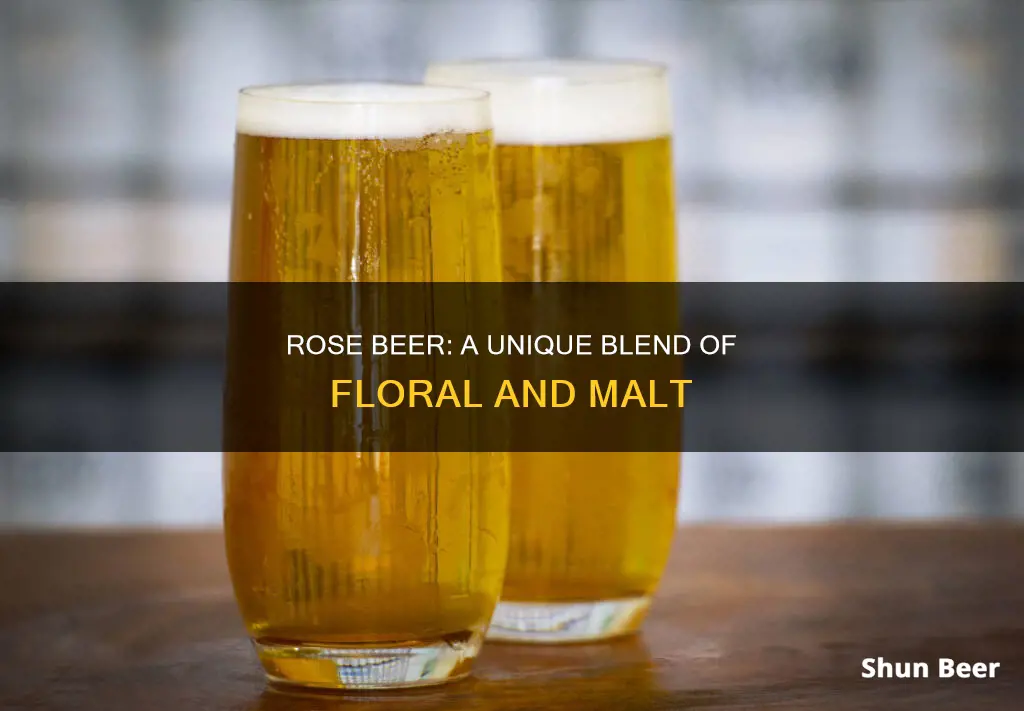
Rosé beer is a hybrid style of beer with a wide variety of recipes and flavours. The only common factor is the pink hue, which can be achieved through the addition of raspberries, beets, red grape skins, or hibiscus. While some rosé beers are made with wine grapes and grains, others are simply a standard beer with something pink added in. The trend has been driven by the popularity of rosé wine, and brewers say it is helping them to attract a new audience of beer drinkers, particularly women.
| Characteristics | Values |
|---|---|
| ABV | 4.4% to 10.2% |
| Colour | Pink |
| Flavour | Fruity, sour, dry, sweet, floral, oaky, earthy, light, refreshing |
| Fermentation | Co-fermented with grape skins or pulp, wine, or other fruits |
| Barrel-Aged | Yes |
What You'll Learn

Rosé beer is a hybrid of beer and wine
Rosé beers are typically made by adding grapes or grape juice during the brewing process or by blending wine with a finished beer. The addition of grapes or wine contributes to the red or pink colour and can add a wine-like character to the beer. Some rosé beers may also be aged in wine barrels or include other fruits or flavourings such as raspberries, strawberries, or hibiscus.
The result is a unique beverage that combines the characteristics of both beer and wine. Rosé beers are often described as having a light, fruity flavour with a subtle wine taste. They tend to have a lower alcohol content than traditional wines, making them a perfect daytime drink for the summer months.
The creation of rosé beers allows brewers to attract new customers, particularly those who typically prefer wine or craft beer. By blending beer and wine, rosé beers offer a unique drinking experience that blurs the lines between the two beverages.
While the future of the rosé beer trend is uncertain, it has undoubtedly captured the interest of drinkers and brewers alike, with many craft breweries experimenting with their own versions of this hybrid beverage.
Exploring Samuel Adams' Diverse Beer Flavors
You may want to see also

It is made by adding grapes during the brewing process or blending wine after fermentation
Rosé beers are made by adding grapes during the brewing process or blending wine after fermentation. This process is known as co-fermentation, which was initially popularized in the wine industry, particularly in France's Rhône region.
Co-fermentation involves fermenting crushed grapes (also called must) alongside the base beer to create a new-age beer-wine hybrid. This method allows brewers to respect the unique characteristics of wine grapes while creating something new.
One example of this process is the Rosalie beer by Firestone Walker Brewing Company. It is made with a variety of local wine grapes, including Chardonnay and Sauvignon Blanc, with a small amount of Muscat, which adds a tropical aroma and flavor. To achieve the desired color, hibiscus flower is added, as the use of white grapes alone does not produce a strong enough pink hue.
Another example is the Sour Rosé by Crooked Stave Artisan Beer Project, which is fermented in oak barrels with raspberries and blueberries, contributing to both the color and flavor of the beer.
Explore the Difference: IPA vs Lager Beer
You may want to see also

It has a relatively low ABV compared to rosé wine
Rosé beers are known to have a relatively low ABV compared to rosé wines. Typically, beers have an ABV between 3.5% and 7%, with some outliers having higher or lower ABVs. For instance, some beers may have an ABV of less than 1%, while certain IPAs might have an ABV above 10%. On the other hand, rosé wines usually have a higher ABV, with an average of around 12%, and can range from 10% to 14% depending on the type of wine.
The lower alcohol content in rosé beers makes them a perfect daytime drink. While a glass of wine can be refreshing, it often has a higher ABV, making it less suitable for extended periods of drinking. Rosé beers, on the other hand, typically have an ABV of around 5%, making them a great choice for a relaxing day by the pool or a beach bonfire.
The ABV of rosé beers can vary depending on the brewing process and the ingredients used. For example, the Rosalie beer from Firestone Walker has an ABV of 5%, while the Rocky Mountain Rosé beer from Avery Brewing has a lower ABV of 4.4%. The brewing process involves using higher amounts of fermentable sugars, which can be achieved by adding more grain to the malt bill or supplementing the malt with simple sugar sources.
The target ABV for a rosé beer can be predicted by brewers before the brewing process by examining the certificate of analysis (COA) of the malts and performing specific calculations. Additionally, a method called forced fermentation can be used to estimate the final ABV by combining pre-fermented liquid with dry yeast and allowing it to ferment for a few days.
While the ABV of rosé beers is generally lower than that of rosé wines, it's important to note that the ABV can vary significantly among different beers and wines. The ABV affects factors such as taste and intoxication levels, so understanding and monitoring the ABV is crucial for both drinkers and beverage producers.
Beer and Cider: Exploring Their Diverse Classifications and Varieties
You may want to see also

It is often aged in oak barrels
Rosé is often associated with summer, freshness, and fun. However, rosé wines are not just aperitif wines, and can surprise with their complexity. While most rosé wines are stored in stainless steel or concrete tanks to preserve their fresh and fruity character, some winemakers choose to age their rosé wines in oak barrels to add subtle flavours and textures. This process is known as "oaking" and results in what is known as "oaked wines".
Oak barrels are traditionally made of wooden staves bound by wooden or metal hoops. The use of oak barrels for ageing wine dates back to ancient times, with evidence of wooden tubs used to store wine found in Egyptian tomb paintings from 1900 BC. The Romans also used wooden casks for storing wine, and the practice has continued to the present day.
Aging rosé wine in oak barrels creates a completely different product compared to aging in stainless steel or concrete tanks. When rosé wine is aged in oak barrels, it takes on new aromas and flavours such as coffee, toast, vanilla, nuts, caramel, spices, and smoked aromas. This adds complexity and layers of aromas to the wine, resulting in what is known as a "barrel rosé".
In addition to the new aromas and flavours, oak barrels have physical characteristics that stainless steel tanks do not have. Oak barrels have a porosity that allows slow oxygenation through the wood. This contact with air rounds out the wine, making it more complex and full-bodied, while reducing the sensation of acidity. The impact of oak ageing on rosé wine can be adjusted by using different sizes and ages of barrels, as well as varying the origin of the wood.
Aging rosé wine in oak barrels is a less common practice compared to aging red or white wines, as it can easily overpower the delicate character of the rosé if not done carefully. However, when done right, oak-aged rosé wines can be a delightful surprise, offering a new style of rosé that is food-friendly and capable of pairing with dishes like dark meat. These "gourmet rosés" are versatile and can be enjoyed during a summer barbecue or festive season, showcasing the versatility of rosé beyond its summer drink image.
Beer Gas vs CO2: What's the Difference?
You may want to see also

It is a popular summer drink
Rosé beer is a popular summer drink. Its rise in popularity is partly due to the success of rosé wines, which are typically associated with warm summer afternoons, lunches in sidewalk bistros, and beach-side bonfires. Rosé beer is a hybrid style with plenty of variety, and its fruity, refreshing qualities make it an ideal summer beverage.
Rosé beers are often crafted with fruit flavours, particularly berries, and tend to be lighter and less alcoholic than traditional wines. This lower alcohol content, typically around 5% ABV, makes rosé beers perfect for daytime drinking. The fruity, refreshing taste of rosé beer also lends itself well to summer, providing a lighter alternative to traditional beers.
The colour of rosé beer is also a significant factor in its popularity as a summer drink. The pink hue, achieved through the addition of ingredients like hibiscus, raspberries, or blueberries, creates a visually appealing beverage that evokes a sense of summer. This Instagrammable colour, along with catchy hashtags, has contributed to the drink's success, especially among millennial women.
Brewers have also capitalised on the summer appeal of rosé beer by marketing it to women, who are typically underrepresented in the craft beer demographic. By targeting a new audience, brewers have been able to expand their sales and attract wine and cider drinkers to the world of craft beer.
Additionally, rosé beer's versatility as a summer drink is demonstrated by its ability to cater to different preferences. While some rosé beers are sweet, others are dry and sour, offering a range of options for consumers. The broad appeal of rosé beer has helped it gain traction as a summer drink, with many people finding it a refreshing alternative to traditional alcoholic beverages.
Japanese Beer: Unique Characteristics Differing from US Brews
You may want to see also







